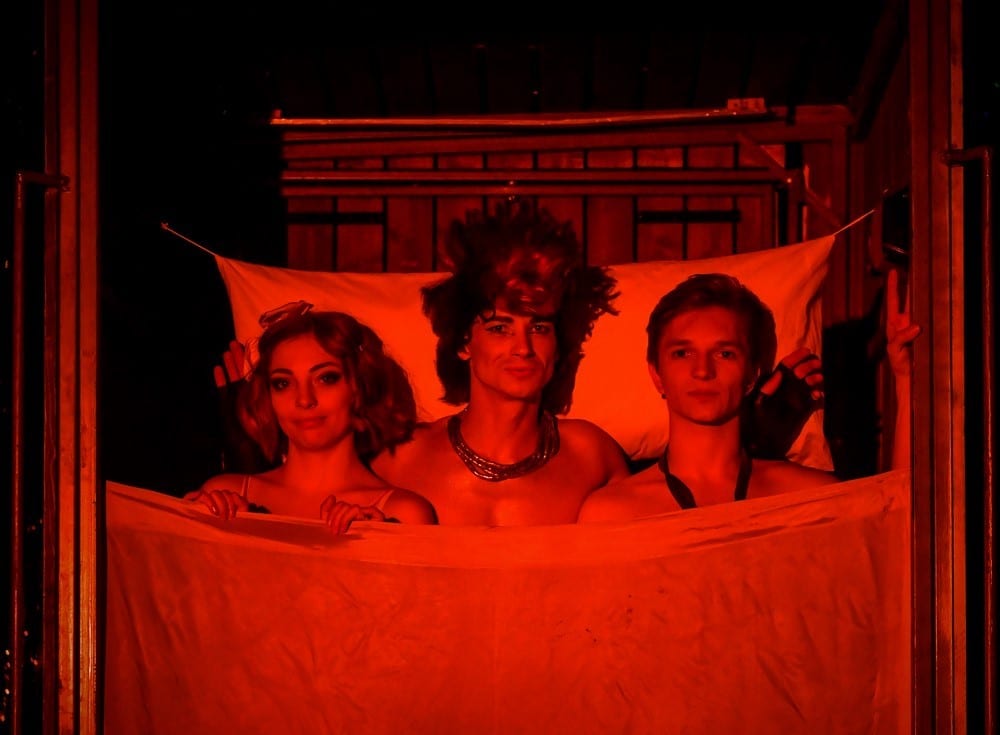The Rocky Horror Show was born, in 1973, as a direct consequence of the tumultuous sexual revolution that peaked at the end of the 60s. Its English author, Richard O’Brien, was naturally influenced by a number of essential literary masterpieces in the British tradition of the outrageous: Mary Shelley’s Frankenstein, Bram Stoker’s Dracula, as well as science fiction novels, to which SF and horror B movies were added.
This by now famous musical is the story of Dr Frank-N-Furter – a humorous name meant to be an allusion both to Dr Frankenstein and to Frankfurter. The character is a transvestite pansexual – a delightful term of our age. The apparent tongue-in-cheek irony of the book is meant to disguise a very serious and disquieting yearning for morally-unbiased orgiastic sex and for a world that is less concerned with brains than with sinews.

Towards the end it is revealed that, together with his followers, Frank has come from Planet Transylvania to engage in liberated sex with Earthlinks. The reference to this Romanian region, used as a hint at Dracula, is received by a Romanian audience with a mixture of amusement, pride and revolt.
The cast of the “Radu Stanca” Theatre asked for a non-conformist venue on purpose. The Spice Pub & Club, cosy and picturesque in itself, is in no way conceived to host performances of any kind. Therefore, the angles were not at all ideal for the spectator, while the ad-hoc stage was definitely too small for the dances.
The appeal of the show lay mainly in that of the musical itself, quite popular with the Bucharest audience due to its film variant. The company were fresh and obviously thrilled with what they were doing, which was contagious and had a very beneficial impact on the audience. Another plus was the fact that the songs were sung in English and only the prose dialogues translated into Romanian, in a variant that was unfortunately full of all sorts of mistakes. Two puns, however, were quite felicitous.
The sets are simple and clever – one wooden box that opens on all sides and rotates, which allows for a great fluidity of the show and makes it practical and easy to adapt to all sorts of spaces when touring.
The screen projections of the show – one of the challenges of any staging of this musical – are also given a good solution – at the centre of the wooden box.
Another good idea is the combination between a negative and live music ensured by Vladimir Petre (drums and violin) and Mihai Rădulea (guitar).
The costumes are pretty and funny, in accordance with those of the other productions of the musical. As usual, Frank changes into a number of corsets and high-heel shoes, while Janet symbolically “progresses” from virginal pink-and-white to a savvy black corset.
Unfortunately, the fact that this is a theatre company, not specialising in musical, takes its toll, as the choreography is painfully simplistic, while the singing is more often than not flat. The English pronunciation is also less than perfect at times.

Ali Deac is a charismatic Frank, a proficient singer with good English pronunciation. His spoken discourse is however artificial, as is Denisa Pintiuță Caian’s as Narrator. On the other hand, Veronica Arizancu and Iustinian Turcu are refreshingly natural as Janet and Brad, while Radu Carp is an extremely handsome Rocky (the Frankenstein-like creation) who achieves an absolutely adorable idiotic glance (as the character has half a brain). Ștefan Tunsoiu dances a smashing rock and roll as the zombie Eddie coming out of the freezer.
All in all, this is an enjoyable performance, albeit produced by a company that is not versed in musicals and therefore does not excel in singing and dancing. Nevertheless, the actors’ obvious pleasure makes the spectator glad to have attended the show.

